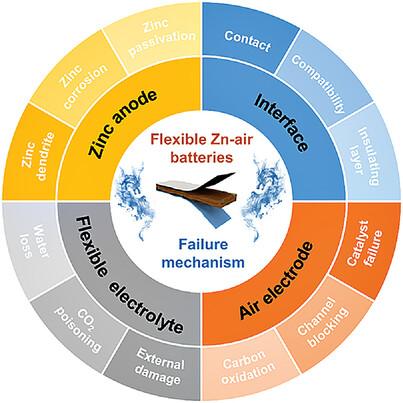当前位置:
X-MOL 学术
›
Adv. Funct. Mater.
›
论文详情
Our official English website, www.x-mol.net, welcomes your feedback! (Note: you will need to create a separate account there.)
Failure Mechanisms and Strategies Toward Flexible Zinc‐Air Batteries
Advanced Functional Materials ( IF 18.5 ) Pub Date : 2024-07-01 , DOI: 10.1002/adfm.202407347 Hengwei Wang 1 , Lingling Kang 2 , Keliang Wang 1, 3 , Manhui Wei 1 , Pucheng Pei 3 , Yayu Zuo 1, 4 , Bin Liang 5
Advanced Functional Materials ( IF 18.5 ) Pub Date : 2024-07-01 , DOI: 10.1002/adfm.202407347 Hengwei Wang 1 , Lingling Kang 2 , Keliang Wang 1, 3 , Manhui Wei 1 , Pucheng Pei 3 , Yayu Zuo 1, 4 , Bin Liang 5
Affiliation

|
Flexible zinc‐air batteries (FZABs) have emerged as a promising alternative to lithium‐ion batteries in flexible electronic devices due to the advantages of excellent mechanical properties, high energy density, and notable safety. However, the unclear causes of performance degradation and failure mechanisms of FZABs significantly impede their commercialization. Therefore, extensive research is needed to fully reveal the factors and mechanisms responsible for the performance decline of FZABs. In this review, the failure mechanisms of FZABs' key components, including the Zn anode, solid electrolyte, catalyst air cathode, and electrolyte/electrode interface are analyzed and discussed. To promote further research and development of FZABs, a series of challenges and corresponding strategies are summarized and analyzed. Finally, the future development of FZABs is envisioned. This paper aims to comprehensively elucidate the failure mechanisms of FZABs, guide the development of high‐performance FZABs, and thus promote their commercialization.
中文翻译:

柔性锌空气电池的失效机制和策略
柔性锌空气电池(FZAB)由于具有优异的机械性能、高能量密度和显着的安全性等优点,已成为柔性电子设备中锂离子电池的有前途的替代品。然而,FZAB 性能下降的原因和失效机制尚不清楚,严重阻碍了其商业化。因此,需要进行广泛的研究来充分揭示导致FZAB性能下降的因素和机制。在这篇综述中,分析和讨论了 FZAB 关键部件的失效机制,包括锌阳极、固体电解质、催化剂空气阴极和电解质/电极界面。为了促进FZAB的进一步研究和发展,总结和分析了一系列的挑战和相应的策略。最后对FZAB的未来发展进行了展望。本文旨在全面阐明FZAB的失效机制,指导高性能FZAB的开发,从而促进其商业化。
更新日期:2024-07-01
中文翻译:

柔性锌空气电池的失效机制和策略
柔性锌空气电池(FZAB)由于具有优异的机械性能、高能量密度和显着的安全性等优点,已成为柔性电子设备中锂离子电池的有前途的替代品。然而,FZAB 性能下降的原因和失效机制尚不清楚,严重阻碍了其商业化。因此,需要进行广泛的研究来充分揭示导致FZAB性能下降的因素和机制。在这篇综述中,分析和讨论了 FZAB 关键部件的失效机制,包括锌阳极、固体电解质、催化剂空气阴极和电解质/电极界面。为了促进FZAB的进一步研究和发展,总结和分析了一系列的挑战和相应的策略。最后对FZAB的未来发展进行了展望。本文旨在全面阐明FZAB的失效机制,指导高性能FZAB的开发,从而促进其商业化。











































 京公网安备 11010802027423号
京公网安备 11010802027423号